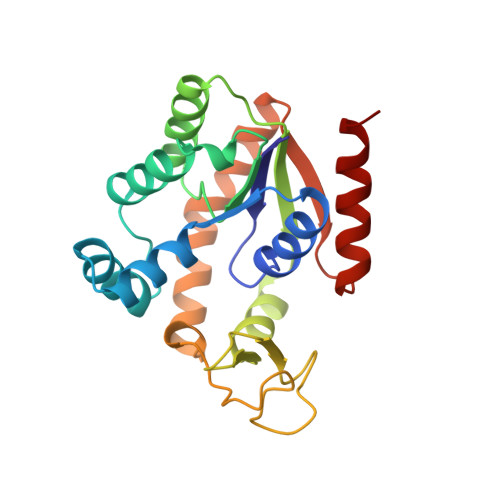Crystal structures of Bacillus stearothermophilus adenylate kinase with bound Ap5A, Mg2+ Ap5A, and Mn2+ Ap5A reveal an intermediate lid position and six coordinate octahedral geometry for bound Mg2+ and Mn2+.
Berry, M.B., Phillips Jr., G.N.(1998) Proteins 32: 276-288
- PubMed: 9715904
- DOI: https://doi.org/10.1002/(sici)1097-0134(19980815)32:3<276::aid-prot3>3.0.co;2-g
- Primary Citation of Related Structures:
1ZIN, 1ZIO, 1ZIP - PubMed Abstract:
Crystal structures of Bacillus stearothermophilus adenylate kinase with bound Ap5A, Mn2+ Ap5A, and Mg2+ Ap5A have been determined by X-ray crystallography to resolutions of 1.6 A, 1.85 A, and 1.96 A, respectively. The protein's lid domain is partially open, being both rotated and translated away from bound Ap5A. The flexibility of the lid domain in the ternary state and its ability to transfer force directly to the the active site is discussed in light of our proposed entropic mechanism for catalytic turnover. The bound Zn2+ atom is demonstrably structural in nature, with no contacts other than its ligating cysteine residues within 5 A. The B. stearothermophilus adenylate kinase lid appears to be a truncated zinc finger domain, lacking the DNA binding finger, which we have termed a zinc knuckle domain. In the Mg2+ Ap5A and Mn2+ Ap5A structures, Mg2+ and Mn2+ demonstrate six coordinate octahedral geometry. The interactions of the Mg2+-coordinated water molecules with the protein and Ap5A phosphate chain demonstrate their involvement in catalyzing phosphate transfer. The protein selects for beta-y (preferred by Mg2+) rather than alpha-gamma (preferred by Mn2+) metal ion coordination by forcing the ATP phosphate chain to have an extended conformation.
Organizational Affiliation:
W.M. Keck Center for Computational Biology, Department of Biochemistry and Cell Biology, Rice University, Houston, Texas 77005, USA.

















